Pansies are known for their cheerful appearance. On closer inspection, you can almost distinguish an upturned face within the flower petals and pistil.
Surprisingly, aside from their uplifting colors, they are also edible. They can be added to cakes, salads and drinks, and the color change of these consumables can be quite amazing.
But, do you know how often to water pansies? Well, I am assuming you don’t, and that’s why you are here at this page.
Pansies need a decent amount of water in short sharp bursts. However, we should approach different watering frequencies for the varying growth different watering frequencies between the varying growth stage. For example, a pansies seedling would require more water than a fully grown plant.
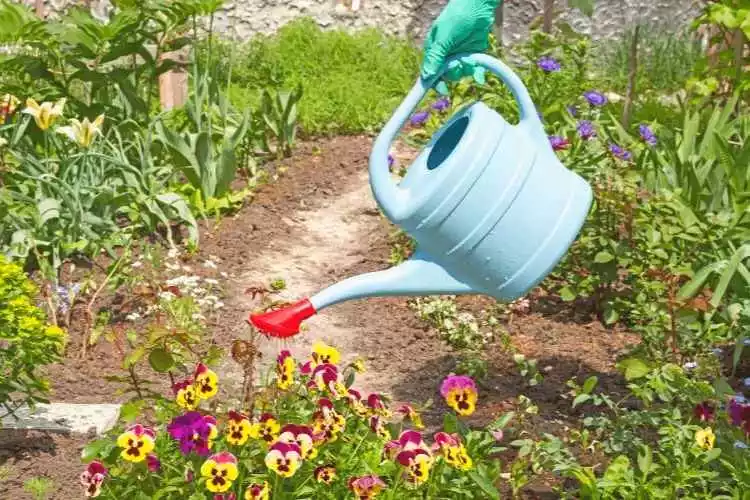
This article will go through exactly when to water them and how much. Doing so whilst following a strict routine will ensure they can survive and thrive in a long and happy life. Let’s dive in, shall we?
Table of Contents
Factors affecting watering frequency
Pansies are quite sensitive flowers, so it’s recommended to be a little careful when watering them. On the one hand, they dry out quite fast, but you also don’t want to soak them to make up for the lack of moisture.
Furthermore, several factors can affect the amount of water pansies should receive. These factors include:
Soil type and drainage
One of the most important rules or guidelines that need to be understood is that every plant requires a certain soil type.
Some need soil that holds moisture, others need well draining soil that allows adequate aeration. It all depends on the plant’s root system and how it establishes itself.
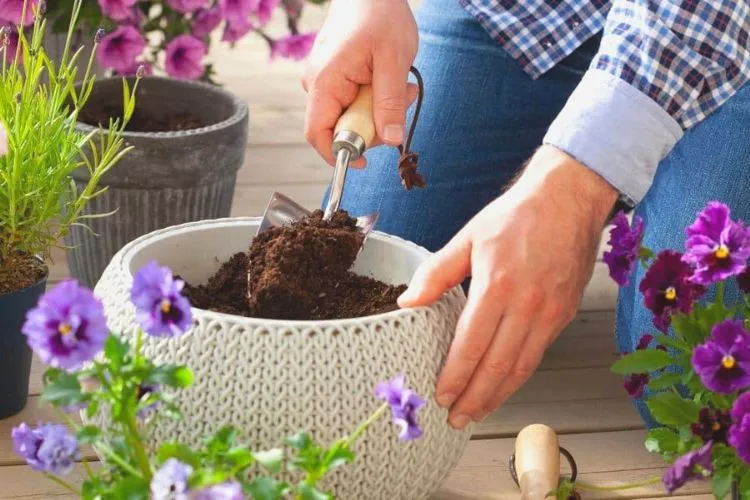
Pansies aren’t extremely fussy like some other plant species. They need a well aerated (loose), rich blended soil (compost, manures, mulches, peat moss, etc.) with adequate drainage.
The soil should be slightly acidic (around 5.8-6.2 pH). If the wrong soil characteristics are applied, the pansies can either take in too much or too little water, which can slow down growth or even kill them.
Temperature and humidity
Pansies are known to tolerate some pretty cold temperatures. It’s not uncommon for them to soldier through a winter that drops to as low as 25°F (-4°C) but any lower will see them wilt and struggle to stay alive.
If you want to see them thrive and flourish, keep their growing temperature at around 40°-60°F (4.5-15.5°C) if possible.
In contrast, they don’t fare too well when exposed to heat above 80-90°F (27-32°C). Excess heats make them weak and leggy and restrict their ability to continue to grow.
The recommended humidity should be around 40-50%, which is similar to the average home.
Warmer temperatures will make the pansies soak up more water more often, meaning they’ll need regular top ups. Whereas colder temperatures will reduce the amount of water, they require.
Sun exposure
Pansies are slightly fragile by nature, so they only require hours of full sunlight per day. Aim to place them somewhere where they can receive this sun earlier and protect them in the hotter parts of the day.
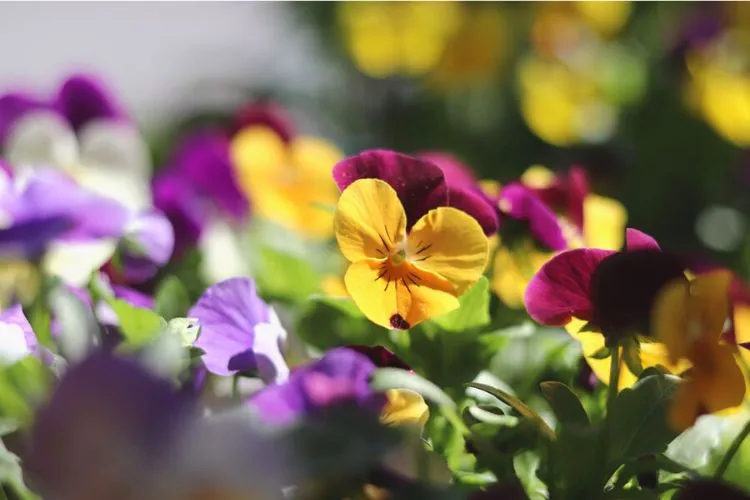
They can burn quite easily when the sun is at its strongest phase. When they are exposed to the sun, they will require more water, more often, as the soil will dry out much faster.
Pansy variety, spacing and size
Most pansy varieties generally require around an inch of water per week, especially during their initial growth periods.
However, some species need varying amounts. These include raspberry swirls which require an average amount, and mammoth pansies, which need that little bit extra to help produce larger flowers.
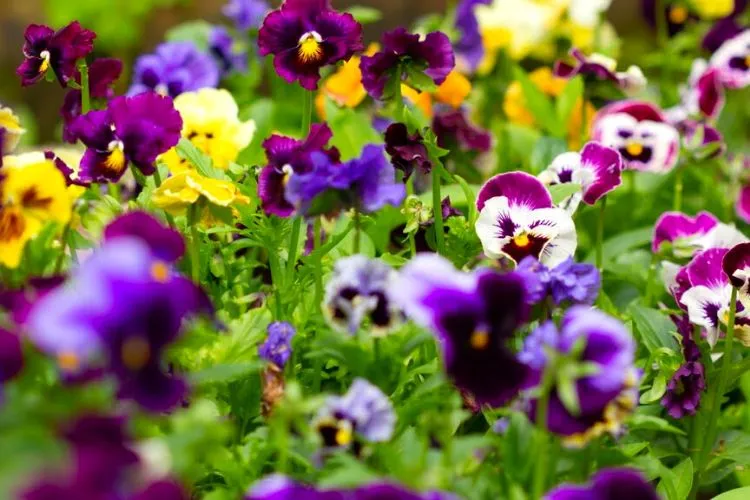
Spacing can affect the amount of water required as the more spread out the pansies are, the more overall water is required to service each plant.
Regarding spacing, it’s recommended to have at least 8-10 inches between each plant to minimize the risk of disease caused by humidity and sweating.
The size of a pansy can also demand more or less water. A newly planted pansy needs at least an inch of water per week, the same goes for one a mature pansy that is grown in a pot. A larger, full pansy doesn’t require as much besides a simple maintenance amount.
How often to water pansies?
As you know beauty comes effort. One of the biggest maintenance issues with pansies is the water required. Especially considering they have extremely sensitive flowers that tend to dry out quickly. That’s not to say that you should soak the heck out of them.
Given that pansies can be a little sensitive to excessive sunlight and heat, it’s best to take a cautious approach when it comes to watering.
A few different factors can determine just how much and how often your pansy plant may need to be watered. One of the most common factors is their stage of growth.
A seedling and a mature pansy require a different watering frequency, as do those growing in a pot or in the ground. Let’s look at the different watering frequencies between the varying growth stages.
How often do you water pansies seedlings?
Seedlings and potted plants (even mature aged) require the same frequency of water. It’s recommended that they receive around 1 inch of water per week. This amount can be distributed in a single application or spread out over the week.
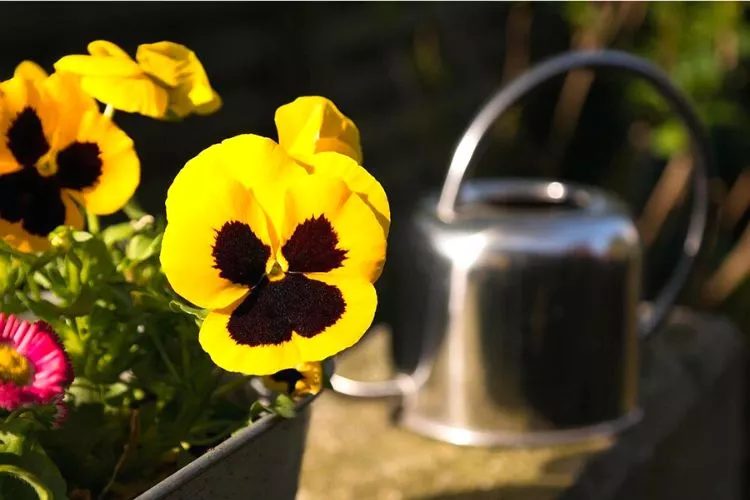
It all depends on many external factors, such as soil characteristics, excess heat, additional watering via rainfall, etc. Regardless of these factors, it’s always best to test the moisture content in the soil before applying any more water.
The reason for their similar water requirements is that potted pansies tend to dry out much faster than those grown in the ground.
Pansy seedlings need more water in their early stages of growth to help the root system fully establish itself. Therefore, they require a little bit more than a fully grown pansy.
How often do you water a fully grown pansy plant?
A fully grown pansy brought to flower in a garden (not a pot or container) requires regular watering but should never be soaked. Giving them an inch over a 2 week period is ideal. They need slightly less than seedlings and pot grown pansies.
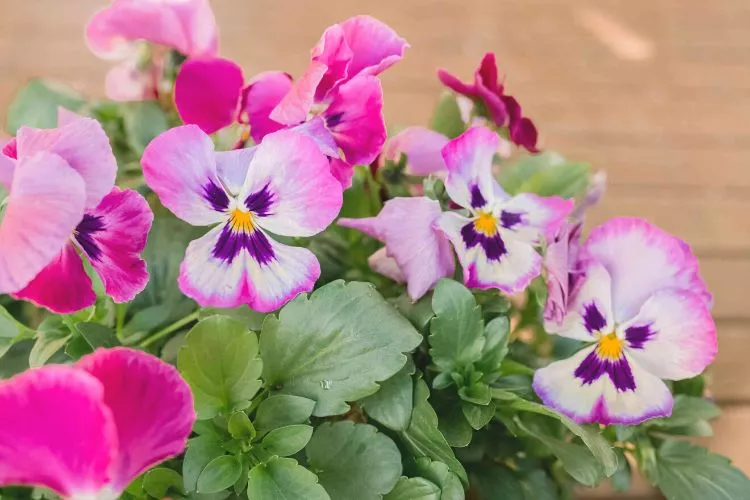
It’s difficult to give an exact frequency as so many variables can affect the moisture content of the soil in which they grow. It’s always a good idea to complete a soil test before giving any water.
This includes sticking your finger down the side of the plant into the soil and checking how wet or dry it is.
If it’s bone dry, then you can water your pansies; otherwise, let the moisture completely dry out before proceeding. Generally, the best time to water pansies is when they show signs of dehydration or distress. This can be revealed by wilting, drooping, dry soil, dropping flowers, etc.
Guidelines for watering pansies
The most effective method of watering a pansy is by testing the soil before each application and allowing it to dry out completely before giving it more moisture. However, a couple of other visual signs can help determine how much water each plant may require.
These include dried and shriveled blooms, wilting, leggy stems, and even flowers. As dire as these signs sound, it doesn’t have to go that far.
Let’s look at some simple steps you can follow to ensure that you are giving your pansies the correct amount of water at an optimal rate.
How to properly water pansies?
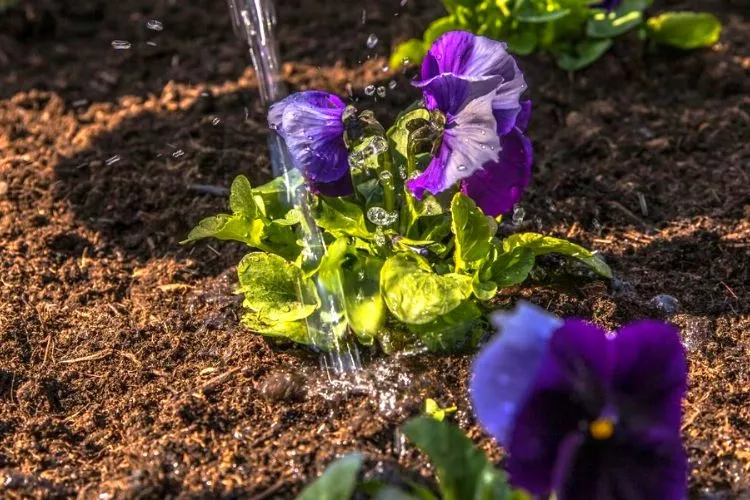
Check the soil moisture levels and observe the plant for signs of water stress
We have already briefly touched on this, but the obvious first step should always be to check the plant and soil. Have a really good feel of the soil, stick your finger into the top inch or 2 and determine whether it’s slightly damp or bone dry.
Always allow the soil to dry out before administering any new water. As far as the plant is concerned, look and see if it seems drooping or if its leaves are wilting. These 2 visual signs point towards plant dehydration.
Water the correct areas
When watering, aim to saturate the soil around the plant’s stem to allow the roots to become wet. This will ensure that it’s not just the topsoil that becomes moist. You want to give the roots a deep watering each time, then let the moisture completely dry out before returning for another hit.
Avoid watering the pansies from above the actual flowers. The flowers will soak in the water and become susceptible to wilting and burning when exposed to the sun’s rays. Furthermore, they dry out much faster as the plant uses its moisture and focuses its energy on saving the flowers instead of continuing to grow.
Make regular checks on the plant
Always keep an eye on these more sensitive types of plants. Be on the lookout for any signs of dehydration. These checks should be done daily or multiple times per day when the conditions are much drier (during a heat wave, for example).
Let any excess water drain away
The main concern is drainage when planting pansies in a container (pot). Aim to administer ample water and allow the excess moisture to drain through the base of the container.
How often to water pansies in different situations?
Pansies are generally not that tricky to water. However, there are different ways to plant or place these wonderful flowering plants that may affect how much water they require. Let’s look at a few situations that could alter the water amount and frequency.
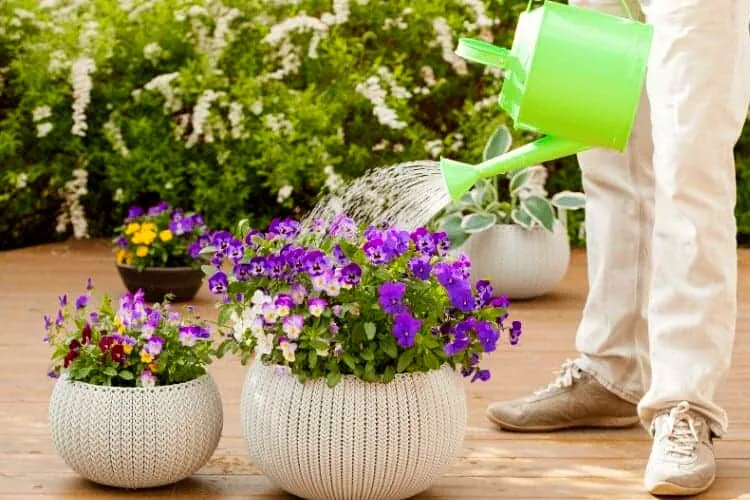
Indoor vs outdoor pansies
When growing pansies indoors, it’s much easier to control their environment. Therefore, it’s not uncommon that they can receive the same amount of water at the same time and thrive quite happily.
In contrast, growing pansies outdoors may make them compete with warmer temperatures or even winds that can dry the soil out much faster. As a result, they may need more moisture more often.
Pansies in containers vs in the ground
Pansies grown in containers generally require less water as it’s much easier to relocate them to somewhere that isn’t affected by diminishing weather conditions.
Heat, wind and even humidity will force the plant to soak the water up much faster. Container grown pansies can be simply moved to avoid these issues.
The only downside with containers is their drainage holes, which could potentially drain out the moisture but are much more controllable than pansies grown in the ground.
When growing them in the ground, the water can simply run past the roots and further down into the earth. It all depends on how well prepared the garden bed soil was.
Pansies during different seasons
Regardless of how pansies are grown, there will always be some element of seasonal stress. Whether they’re battling extreme heat, cold, winds, or humidity, the different seasons will require them to be protected.
The only real way to avoid any weather issues is by placing the pansies inside a house or somewhere similar where the environment can be more easily controlled.
Signs Of Overwatering And Under-Watering
When a pansy receives too much water, it will become starved of oxygen as the excess water suffocates the root system. As a result, it will not be able to access any form of nutrition.
The plant will slowly die as this condition continues without being discovered and consequently treated. The symptoms of this condition include plant discoloration, stunted growth, dying leaves and dieback.
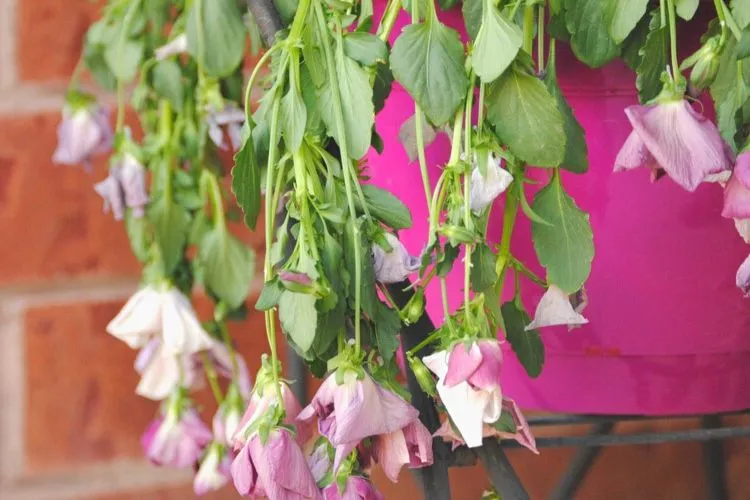
In contrast, underwatering a pansy will make its leaves wilt and droopy. This condition simply means that they are becoming dehydrated.
They will slowly dry out and die if no corrective measures are taken. They need water as it is an integral ingredient in the photosynthesis process. No water means no growth due to malnutrition and slow dehydration.
Advanced watering techniques
Pansies aren’t too fussy with how they get their water as long as they get it when they need it. Let’s look at a few intricate techniques that can help remove any guesswork surrounding the watering process.
Drip irrigation
Drip irrigation systems are an amazing piece of technology, especially for pansies. The beauty of a system like this is that they can be set up to run on a timer which helps to take a bit more of a hands off approach. Additionally, drip systems can be installed so that the nozzles administer the water in the perfect location.
Sometimes even hand watering can spill on the flowers, which can cause burning by the sun. Drip systems, on the other hand, deliver the exact amount at the right time in the right place.
Mulching
Mulching has been used for eons and is a great method of keeping just the top portions or layers of the soil moist. As the water is administered, it is soaked up by the mulch and acts as a slow moisture release.
Otherwise, simply soaking a pansy plant can cause major problems by drawing out the root system. As a result, the roots can form rot as they dangle in any stagnant water stores that may pool in air pockets underground.
Watering with rainwater
It’s obvious that growing anything as nature intended is usually the best growth method. Pansies are no different. Having them grow outdoors in a garden is usually the best method, although many more issues need to be controlled.
However, allowing them to receive their water from the heavens above is the most natural way they can be watered. Otherwise, using a source of water that is filtered is optimal. Regular tap water generally contains harder minerals that don’t break down in the soil and react to certain parts of the plant.
Frequently Asked Questions (FAQs)
Do pansies like to be wet or dry?
Pansies love good watering but will not tolerate soggy roots. It’s always best to check the condition of the soil before administering any water. If the top 1-2 inches of the soil is bone dry, give them a decent amount of water (without soaking them).
If growing in a pot, give them enough water so it drains out the bottom of the container. Those growing in the ground must be monitored a little more carefully.
Can you water pansies too much?
Pansies enjoy the water but don’t like it so much that the root system suffocates in the excess moisture. It’s always best to inspect the plant and its soil for indications of water stress before proceeding to administer more water. You can feel the ground to gauge the dampness and apply as needed.
Should you water pansies every day?
The amount of water and frequency can be affected by several factors. Therefore, it’s difficult to determine whether they should be watered daily. For example, growing a pansy in a warm and dry climate might require the plant to receive water daily instead of growing one somewhere that is cooler or even wet.
Mornings are an optimal time to water these types of plants since it is usually cooler. This allows the plants to hydrate before the afternoon sun and heat can have any overbearing effect.
Conclusion:
It’s safe to say that pansies enjoy good watering. However, they don’t tolerate soggy roots. When the root system is soaked, they suffocate and stop growing due to malnutrition.
The best method of administering water is by first checking the moisture content of the soil. If the top 1-2 inches is dry, apply water;
Otherwise, wait until it is dry. Allow these plants some good morning sun but offer protection from any extreme afternoon heat. Aside from that, these bad boys are a beauty and a breeze to grow.
We hope that this guide has been helpful. You can read about similar topics here on our website. Check back again soon for more.


